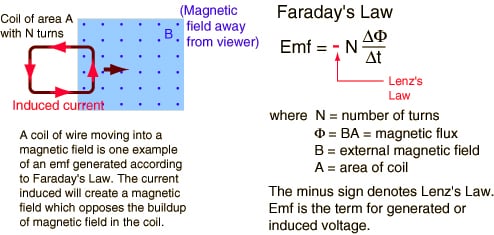With this definition of the flux being, we can now return to Faraday’s investigations. He found that the magnitude of the emf produced depends on the rate at which the magnetic flux changes. This fundamental result is known as Faraday’s law of induction.
The minus sign is placed there to remind us in which direction the induced emf acts. Experiment shows that an induced emf always gives rise  to a current whose magnetic field opposes the original change in flux. This is known a Lenz’s law. Let us apply it to the case of relative motion between a magnet and a coil. The changing flux induces an emf, which produces a current in the coil; and this induced current produces its own magnet field. If the distance between the coil and the magnet decreases; so the magnetic field, and therefore the flux, through the coil increases. The magnetic field of the magnet points upward. To oppose this upward increase, the field produced by the induced current must point downward. Thus Lenz’s law tells us that the current must move by the use of the use of the right hand rule. If the flux decreases, so the induced current produces an upward magnetic field that is “trying” to maintain the status quo.
to a current whose magnetic field opposes the original change in flux. This is known a Lenz’s law. Let us apply it to the case of relative motion between a magnet and a coil. The changing flux induces an emf, which produces a current in the coil; and this induced current produces its own magnet field. If the distance between the coil and the magnet decreases; so the magnetic field, and therefore the flux, through the coil increases. The magnetic field of the magnet points upward. To oppose this upward increase, the field produced by the induced current must point downward. Thus Lenz’s law tells us that the current must move by the use of the use of the right hand rule. If the flux decreases, so the induced current produces an upward magnetic field that is “trying” to maintain the status quo.
Let us consider what would happen if Lenz’s law were just the reverse. The induced current would produce a flux in the same direction as the original change; this greater change in flux would produce an even larger current, followed by a still larger change in flux, and so on. The current would continue to grow indefinitely, producing power (=) even after the original stimulus ended. This would violate the conservation of energy. Such “perpetual – motion” devices do not exist.
It is important to note, which I believe was forgotten in the class lecture, is that Faraday’s investigation, as summarized in Faraday’s law, says that an emf is induced whenever there is a change in flux. Thus an emf can be induced in two ways: (1) by changing the magnetic field B; or (2) by changing the area A of the loop or its orientation theta with respect to the field.
A motor turns and produces mechanical energy when a current is made to flow in it. You might expect that the armature would accelerate indefinitely as a result of applied torque. However, as the armature of a motor turns, the magnetic flux through the coil changes and an emf is generated. This induced emf acts to oppose the motion (Lenz’s law) and is called the back or counter emf. The greater the speed of the motor, the greater the back emf. Indeed, as the motor increases in speed, the back emf increases until a balance is reached where the speed remains constant. Thus the counter emf controls the speed of a motor.
For a given coil, the ratio of the electromotive force of induction to the rate of change in the coil is called the self-inductance of the coil. An alternative definition of self-inductance is the number of flux linkages per unit current. Flux linkage is the product of the flux and the number of turns in the coil. Self-inductance does not affect a circuit in which the current is unchanging, however, it is of great importance when there is a changing current, since there is an induced emf during the time that the change takes place.
The mutual inductance of two neighboring circuits is defined as the ratio of the emf induced in one circuit to the rate of change of current in the other circuit. The SI unit of mutual inductance is the Henry, the same as the unit of self- inductance. The same value is obtained for a pair of coils, regardless of which coil is the starting point.
